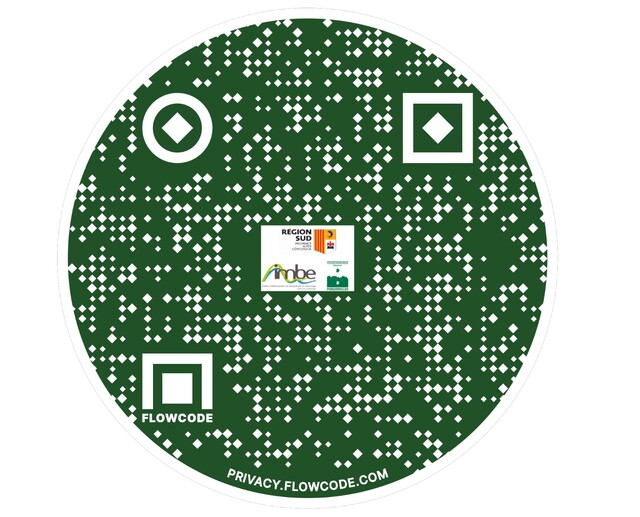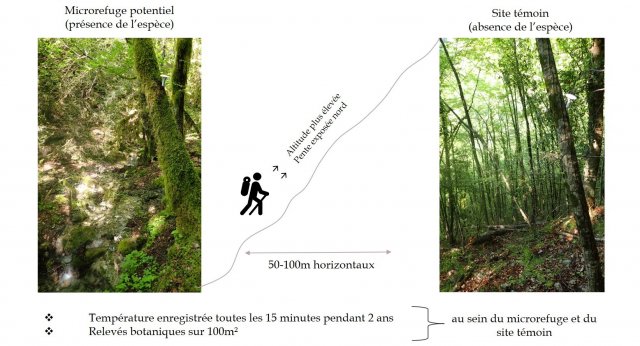MICROMED - Conservation de la flore face au réchauffement climatique : caractériser, cartographier et évaluer le rôle des microrefuges en région Sud-PACA
Project description :

Microrefugia are small areas where populations persist outside their species range, supposedly because favorable microenvironmental conditions. Studies about microrefugia often aim to identify and quantify the relationships between topography, forest management and microclimate to use their results to discuss landscape configurations that may lead to the emergence of microrefugia. However, the direct link between microclimate and microrefugia may not be as obvious as it seems. The very hypothesis of a microclimate within microrefugia remains to be demonstrated and the level of sensitivity of species to microclimatic variations remains unknown. In the MICROMED project, co-financed by the SUD-PACA region and the Mediterranean National Botanical Conservatory, we carried-out a bottom-up approach, from the putative microrefugia to the microclimate and the landscape, to better understand the functioning of these very special microsites. We attempted to identify current microrefugia for two species with circumboreal and alpine distribution, Oxalis acetosella and Arabis alpina, respectively, at the southern and lowermost limits of their range in the Mediterranean region. For these two species, we looked for populations that were exceptionally meridional or low in altitude, disjunct from the respective distribution range of the two species. By doing so, we could identify around thirty sites that could be assimilated as current microrefugia. Climate monitoring, botanical inventories and recording of many variables (commonly described as a microclimate forcing factor, of a topographical nature or related to forest management) were carried out in each of these microrefugia. For each microrefugium, these measurements were repeated in a “neighboring” site located only 50 m away, systematically placed at a higher altitude and facing north, so as not to force a warmer microclimate in the neighboring sites.
To date, climate data have been analyzed for only half of the sites. These results corroborate the existence of a colder microclimate in the microrefugia, and especially for the abyssal sites (exceptionally low in altitude). The daily temperature difference between microrefugia and neighboring sites is -1.1°C on average and intensifies to -1.6°C in summer for maximum temperatures, which corresponds to about twenty years in terms of climate change. These microrefugia, which are generally located in topographic depressions and under cover of a deciduous forest, benefit from a thermal inversion which surprisingly persists throughout the year. This microclimate is sufficiently distinct to significantly impact the plant communities, with significantly higher frequency of species with colder temperature and moister humidity optima in the microrefugia. The rest of the project will focus on the possible decoupling processes of the microclimate in the microrefugia, i.e. the ability that these microsites would have to minimize the ongoing global warming. Based on all findings, we will try to propose sites that can serve as a microrefugia for species threatened by global warming.
In addition, we have setup a network a monitored sites in the Saint-Baume area (Paradis - Pas de l’ail) where several populations of Arabis Alpina could be found (the bioclimatic Observatory SAINTOBS). We are monitoring climate and floristic data in about 70 sites within a 30Ha area to better understand the scale of biological responses to microclimatic variations and to assess if and how marginal populations make use of such microclimatic variations. The First results will be available soon.
Team members :
Marie Finocchiarro (PhD student), Frederic Médail (Pr IMBE), Katia Diadema (CBNMed), Arne Saatkamp (MCF IMBE), Daniel pavon (IE IMBE), Eric Meineri (MCF IMBE)
References :
Finocchiaro, M., Médail, F., Saatkamp, A., Diadema, K., Pavon, D. and Meineri, E. (2022), Bridging the gap between microclimate and microrefugia : a bottom-up approach reveals strong climatic and biological offsets. Global Change Biology. Accepted. https://doi.org/10.1111/gcb.16526





